HYBRIS 2017: ABOUT – ARTISTS AND WORKS – CURATORIAL TEXTS – CONTACTS – PRESS
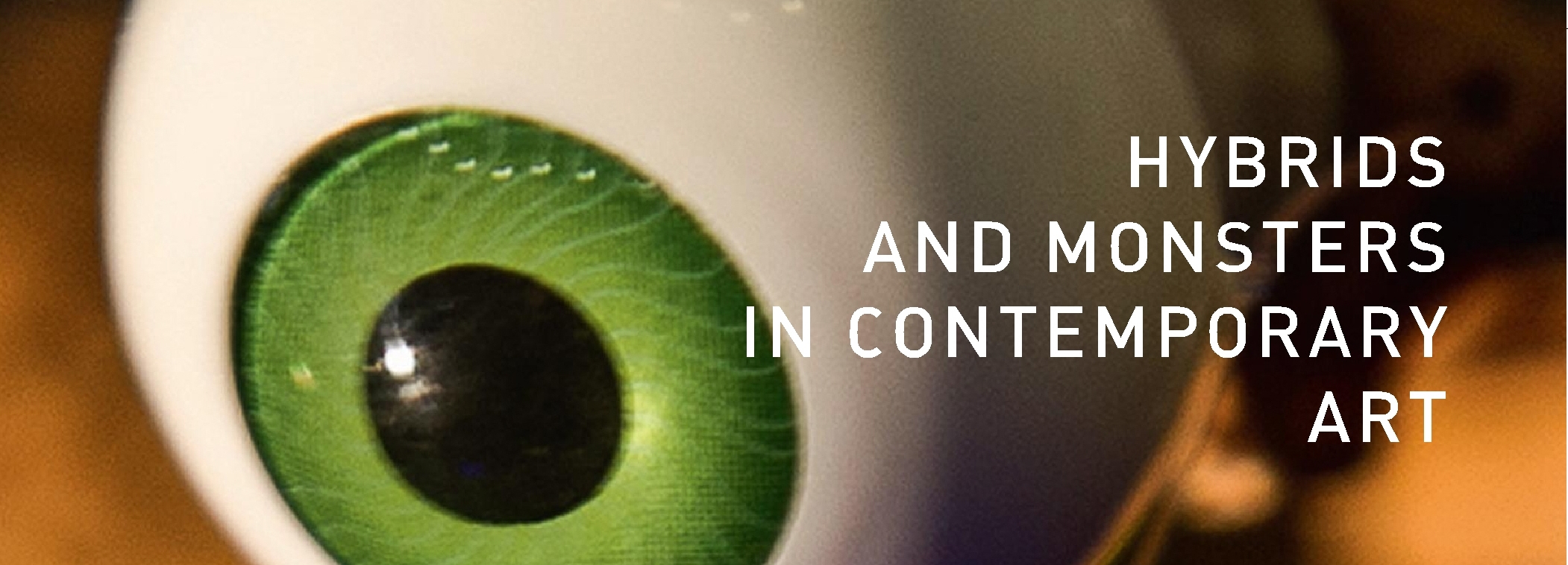
ARTISTS AND WORKS:
William Latham (UK) - Mutator
Generated by “Mutator” software. Software development: Stephen Todd, Lance Putnam.

“Mutator” shows synthetic 3D organic forms evolving as projected computer animation and in real time in VR. The viewer is navigating through a vast multidimensional space of possible forms.
William Latham
Artist, computer scientist. Born in 1961 in the UK. Originally trained as an artist at the Oxford University (UK) and the Royal College of Art (London, UK). Well known for his evolutionary art created from 1987 to 1993 whilst a Research Fellow at the IBM Scientific Centre in Winchester, UK. His pioneering organic art based on the concept of “evolution by aesthetics” was shown widely in major touring shows in the UK, Germany and Japan in the 1990s. From 1993 to 2003 he worked in rave music and computer games development working with Universal, Sony SCEE and Warner Bros. In 2007 Latham became Professor of Computer Art at Goldsmiths (University of London, UK) and returned to his artistic origins and restarted his long term collaboration with mathematician Stephen Todd. Since 2015 he has worked extensively in VR developing “Mutator VR”. Lives and works in London, UK.
Natalia Lyakh (Fr) - Untitled

Video-investigation of everyday things, their reflections, distortions, transformations. “Lamps swinging in the wind, throwing red eyes in a puddle… foam cocktail structure… magic movement of car’s internal mechanism displayed in showroom… surface’s secrets. No special effects: a closer shot. It is not a fictional world. There is a diversion of the world. The motion combines organic and nonorganic worlds. Movement forms are deformed by sound. The association is between the contrast image-sound. We are taken away by the time, the speed and the rhythm”. V. Mazin
‘Listen to the beating heart through a simple ice cube.
Natalia Lyakh
Artist. Born in St. Petersburg, Russia, from her early childhood Natalia was passionate about painting, sculpture and photography. Later on, she developed a strong interest in science and got her Ph.D. in Neurolinguistics on the subject of Brain Asymmetry and Speech Processing. Several years of a scientific career were not, however, a hindrance to her artistic development as she continued to experiment with photography and got involved in video art. Since 2000, Natalia has devoted her full-time attention to photography, video art, short films and video installations, working in Paris, Stockholm, Istanbul, Milan, Rome, New York and London and participating in various art shows and festivals. Influenced by her former neurolinguistics research, she invites us to discover the magic dimensions and abstractions, hidden in simplest objects that surround us, as seen through the lens of a microscope, the prism of binoculars, telescope or kaleidoscope. She currently lives and works in Paris, France.
Alexander Terebenin (Ru) - Triptychs
Supported by CYLAND MediaArtLab
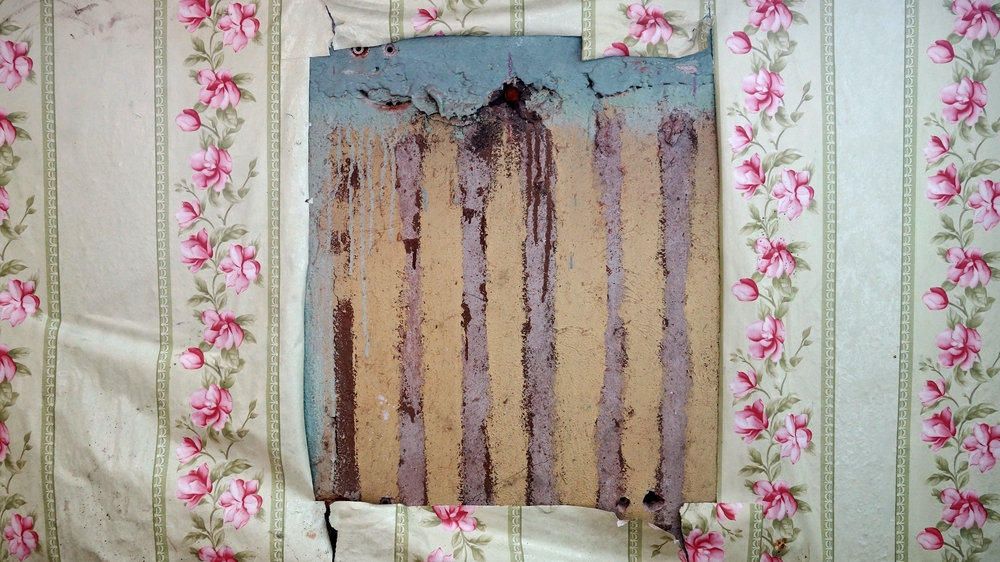
The triptych form originated in the early Christian art, and it was a popular format for religious paintings in the Middle Ages. The middle part contained the main subject, and the wings were a compositional complement, though they too could be viewed as a separate work.
In the early XX century, a threefold polyptych inspired Kazimir Malevich. Originally, his “Black Square” was called “Tetragon”, and it was a component of the triptych, together with “Black Circle” and “Black Cross”. Alexandre Benois noted: “Undoubtedly, this is indeed the icon which Messieurs Futurists prefer to Madonnas and impudent Venuses”.
A hundred years after the advent of “Black Square”, Alexander Terebenin has created a minimalist and abstract triptych, using the pictorial geometry of vanishing scenery. The squares, rectangles, crosses, “spied on” by a camera, are written into the three-part format. Traces of life of the previous generations turn into secret signs and sacral symbols.
Alexander Terebenin
Photographer, artist, curator. Born in 1959 in Leningrad, USSR.
Graduated from the Architectural College in Leningrad. A professional photographer, Terebenin also creates art objects and installations. He is a participant of over 70 exhibitions in Russia and abroad. His works are in the collections of the Museum of the History of St. Petersburg (Russia), Kolodzei Art Foundation (New York, USA),
as well as in galleries and private collections in Russia, USA, Israel, Germany and Finland. He is the curator of the art projects “Conversion” (Russia, 2012) and “Signal” (St. Petersburg, Russia, 2014). He won the Innovation Prize (Russia) for the best curatorial project of 2014 (in collaboration with Peter Belyi). Lives and works in St. Petersburg, Russia.
Lucia Veronesi (It) - Untitled landscape #5

Untitled landscape #5 faces the catastrophe, like the rest of the video series. The violent transformation wipes out any illusion of safety. Houses, gardens, basins, swimming pools: everything that was made to protect human life gives up, suffering its own opposite. Infiltrations, rocks and floodings creep into the furnished rooms. Revolting creatures replace the statues in the garden. The polished marble of the sculptures is covered by shapeless rocks. Uncontrollable plants come out of the ground and crumble the bottom of the swimming pool. A tranquil telescope turns into a bullet, the glance is a punch that beheads all it sees. A barbarian power invades, disintegrates, mocks. The eyes can only look through layers of incisions, the sky has turned into a shutter of cuts that falls on its own image. If knowledge and experience want to remain reliable, they will necessarily have to take the view of the catastrophe.
Lucia Veronesi
Artist. Born in 1976 in Mantua, Italy. Graduated from the Academy of Fine Arts of Brera (Milan, Italy). Veronesi is interested in landscape and its transformation. The core of her research is uninhabitable and dysfunctional space caused by the volume of whatever was used and experienced. Hence, the inhabitable domestic space turns into a sort of wild landscape and in fact, by interacting with the natural external landscape, it is invaded and absorbed. Her videos were selected for several festivals including the Torino Film Festival (Turin, Italy), Oblíqua Festival (Lisbon, Portugal), Oodaaq Festival (Rennes, France), Montreal Underground Film Festival (Canada), and others. Lives and works in Venice, Italy.
Vitaly Pushnitsky (Ru) - Studio. Waiting
Supported by CYLAND MediaArtLab
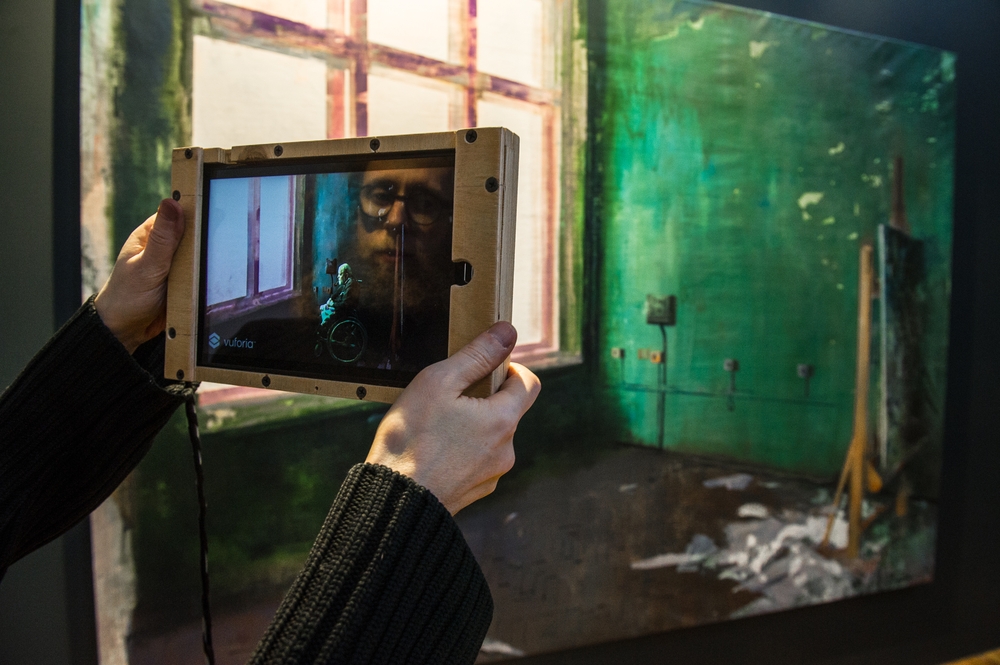
The project “Studio. Waiting” is a large-format canvas with an attached device that allows to see the story anew and to refresh the image without the intrusion of one art form into another. This is an attempt visually to demonstrate both independence and coexistence of the traditional form — painting — and the newest means of augmented reality. The project investigates game theory (including a game with an absent character) in its contemporary, virtual-psychological aspect. The picture is separated from the device; nothing is projected onto it. It serves just as a switch-on point, a pretext to expand the boundaries imposed by the bored glance of a visitor to the exhibition. The painting and the program live and work together, much like people coexist on networks. This peculiar symbiosis allows to bring technology to a discussion of the same questions that are posed by classical art.
Vitaly Pushnitsky
Artist. Born in 1967 in Leningrad, USSR. Graduated from the Ilya Repin State Academy Institute of Painting, Sculpture and Architecture (Leningrad, USSR). Pushnitsky participated in major group exhibitions in Europe, USA and Russia, including the Venice Biennale (parallel program, Italy, 2007) and the Moscow Biennale (Russia). He had numerous solo shows in museums and galleries in Russia and around the world. His works are in various public collections, such as the Russian Museum (St. Petersburg, Russia) and Moscow Museum of Modern Art (Russia), and in many private collections. Lives and works in St. Petersburg, Russia.
Ivan Govorkov and Elena Gubanova (Ru) - Geometry of Classics (Series)
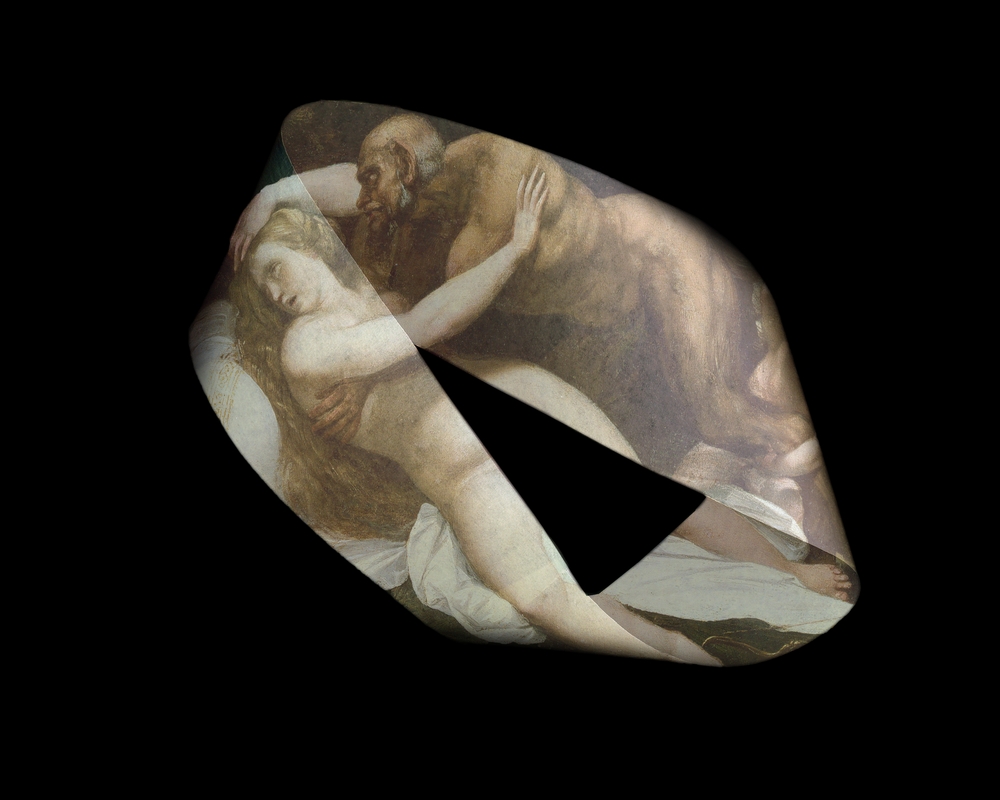
The series of pictures “Geometry of Classics” is conceived by the authors as part of the investigation of patterns of plastic configuration of images in the classic art.
A projection of topological space of the unilateral surface of “Moebius Strip” on famous paintings of the Renaissance demonstrates that many compositions of the old masters are structured in accordance with its crisp geometry. By creating a plastic hybrid of painting and topology, the artists suggest that the viewer return to the ancient view of the world, in which mathematics and art were capable of describing the entire Universe.
“Time and space are the Moebius Strip;
The human body is the Moebius Strip;
The entire life is the expectation of properties of Moebius Strip.
Everything is present in the ‘non-presence’;
Everything exists in the ‘nonexistence’.”
I. Govorkov
Ivan Govorkov
Artist. Born in 1949 in Leningrad, USSR. Graduated from the Ilya Repin State Academy Institute of Painting, Sculpture and Architecture (Leningrad, USSR). He is engaged in philosophy, psychology, painting, drawing, sculpture and installations; he works at the junction of traditional art and cutting-edge technologies. Professor of drawing at the Ilya Repin Institute. Recipient of the Sergey Kuryokhin Award (Russia, 2012) in the category “Best Work of Visual Art” (together with Elena Gubanova). His works have been exhibited at major Russian and foreign venues, including the Hermitage Museum (St. Petersburg, Russia), the Russian Museum (St. Petersburg, Russia), Museum of Moscow (Moscow, Russia), University Ca’ Foscari (Venice, Italy), Chelsea Art Museum (New York, USA), Kunstquartier Bethanien (Berlin, Germany), Sky Gallery 2 (Tokyo, Japan). Participant of the Manifesta 10 Biennale Parallel Program (St. Petersburg, Russia, 2014) and several exhibitions parallel to Venice Biennale (Italy, 2011, 2013, 2015); many times participant of the Cyfest Festival. Since 1990, he has been working in collaboration with Elena Gubanova. Lives and works in St. Petersburg, Russia.
Elena Gubanova
Artist, curator. Born in 1960 in Ulyanovsk, USSR. Graduated from the Ilya Repin State Academy Institute of Painting, Sculpture and Architecture (Leningrad, USSR). She is engaged in painting, sculpture, installations, and video. Gubanova’s principal interest as an artist is to explore the time-space notion in a social context and to present scientific discoveries through the figurative language of art. Recipient of the Sergey Kuryokhin Award (Russia, 2012) in the category “Best Work of Visual Art” (together with Ivan Govorkov). Her works have been exhibited at major Russian and foreign venues, including the Hermitage Museum (St. Petersburg, Russia), the Russian Museum (St. Petersburg, Russia), Museum of Moscow (Moscow, Russia), University Ca’ Foscari (Venice, Italy), Chelsea Art Museum (New York, USA), Kunstquartier Bethanien (Berlin, Germany). Participant of the Manifesta 10 Biennale Parallel Program (St. Petersburg, Russia, 2014) and several exhibitions parallel to Venice Biennale (Italy, 2011, 2013, 2015); many times participant of the Cyfest Festival. Since 1990, she has been working in collaboration with Ivan Govorkov. Lives and works in St. Petersburg, Russia.
www.elenagubanova.com
Anna Frants (Ru-USA) - Explosion of a Can of Condensed Milk After the Water Has Evaporated
Supported by CYLAND MediaArtLab
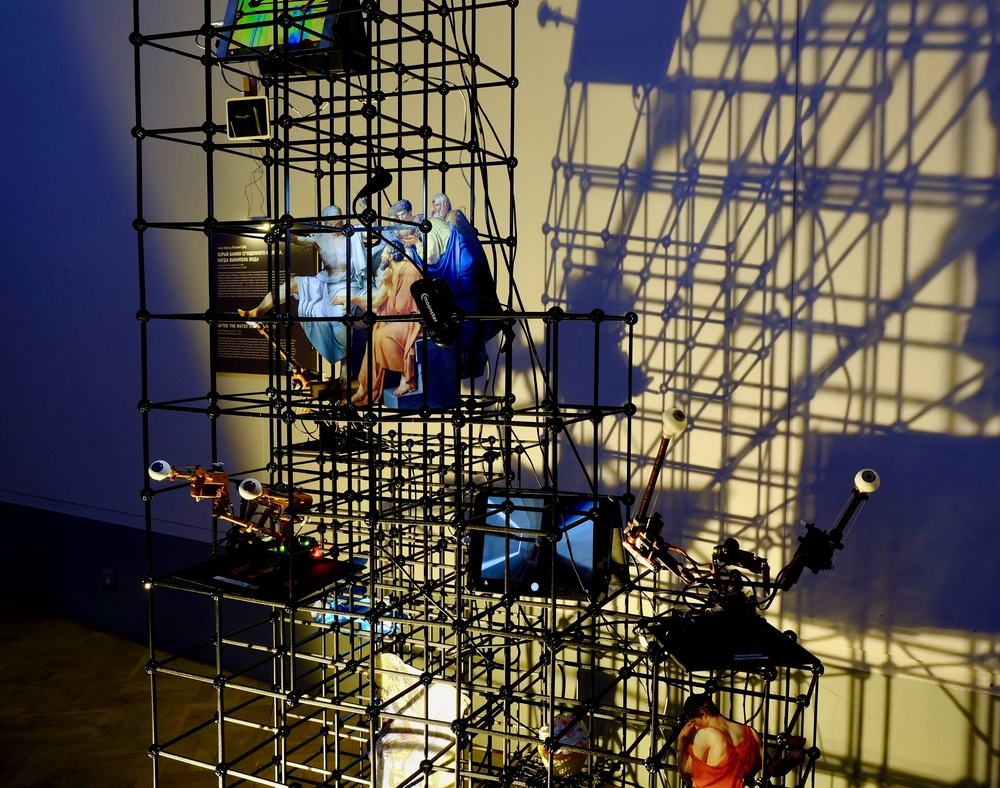
Conceptually referencing a computer grid and visually reflecting the infrastructure of a building without walls, Anna Frants builds an open framework room. Comprised of raw polypropylene cubes, the exposed framework houses objects, videos, and movements. The interior (unlived-in lived-in) space is empty for viewers to navigate the visuals, sounds, words, and virtual actions of the exterior matrix and formulate their own story. Birds chirp, recorded faces communicate, playful toys whiz and whirl, the seas ebb and flow — each with brand names that they are sold as or known by as characters in Frants’ theatrically staged work and beyond. At first glance reminiscent of “The End” or “Mad Max”, this multimedia environment is less а scene from a dismal future and more an intimate setting presented for a poetic contemplation of the sense of self. The installation is flexible, varying from site to site and country to country, with local materials utilized each time.
Anna Frants
Artist, curator in the field of media art. Born in 1965 in Leningrad, USSR. She graduated from the Vera Mukhina Higher School of Art and Design (Leningrad, USSR) and Pratt Institute (New York, USA). Cofounder of the nonprofit cultural foundation St. Petersburg Arts Project, CYLAND Media Art Lab and Cyfest Festival. Frants’ interactive installations have been showcased at Moscow Biennale of Contemporary Art (Russia), Video Guerrilha Festival (Brazil), SIGGRAPH Asia Conference (Hong Kong), Manifesta 10 Biennale (St. Petersburg, Russia, 2014), Museum of Art and Design (New York, USA), the Hermitage Museum (St. Petersburg, Russia), Chelsea Art Museum (New York, USA), the Russian Museum (St. Petersburg, Russia), Kunstquartier Bethanien (Berlin, Germany) and at other major venues all over the world. The artist’s works are in the collections of the Russian Museum (St. Petersburg, Russia), Museum of Art and Design (New York, USA), Sergey Kuryokhin Center for Modern Art (St. Petersburg, Russia) and Kolodzei Art Foundation (New York, USA) as well as in numerous private collections. Lives and works in New York, USA, and St. Petersburg, Russia.
Carla Gannis (USA) - A Subject-Self Defined

Carla Gannis’s A Subject Self-Defined, a collection of large-format looped moving images, takes its title from Joseph Kosuth’s 1966 neon sculpture that spells out and is eponymously titled “A Subject Self-Defined.” Kosuth belonged to a group of artists involved in stripping down the art object, reducing it to ideas and information that were detached from personal meaning. Fifty-one years later, in the age of networked identity and digital dematerialization, Gannis is perplexed by subjecthood and self-definition in relationship to the “personal” when performed publicly.
Carla Gannis
Artist. Born in Oxford, North Carolina, USA. She received a BFA in painting from the University of North Carolina (Greensboro, USA) and a MFA in painting from Boston University (USA). In the late 1990s she began to incorporate digital technologies into her work. She narrates through a “digital looking glass” where reflections on power, sexuality, marginalization, and agency often emerge. She is fascinated by contemporary modes of digital communication, the power (and sometimes the perversity) of popular iconography, and the situation of identity in the blurring contexts of technological virtuality and biological reality. Since 2003 Gannis’s work has appeared in 20 solo exhibitions and numerous group exhibitions both nationally and internationally. Currently she is a professor and assistant chairperson of the Department of Digital Arts at Pratt Institute (New York, USA). Lives and works in Brooklyn, New York, USA.
Irina Nakhova (Ru-USA) - Observation Post
(observation post = voting booth = bunker)

The rapidly deployed booth is constructed out of a thick protective quilted jacket.
Each booth has two pairs of sleeves to choose from:
a) if so desired, an observer could try to reach the hands of another observer from a different booth or b) use the sleeves as a strait jacket. Each post is equipped with a voice servicing the observer:
Periodically, the voices whisper a program of international monitoring:
peace… pax… pace… мир… paix… Frieden… etc.
Irina Nakhova
Artist. Born in 1955 in Moscow, USSR. Graduated from the Moscow Polygraphic Institute (USSR). Early member of what came to be known as the school of Moscow Conceptualism. Pioneer of the genre of total installation in Soviet underground art. Nakhova concurrently works with painting and installation, the most vivid of which employs painting, digital printing, sculpture and interactive video and audio. In 2013, she won the Kandinsky Prize (Russia) in the category “Project of the Year” for “Untitled”, an installation that uses photography and film from the 1920s until today from her own personal archive. Since 1989, her work has been exhibited throughout Europe and the USA. Nakhova has been selected to have a solo exhibit at the Russian Pavilion for the 56th Venice Biennale (Italy, 2015). Lives and works in Moscow, Russia, and in the USA.
Alexandra Dementieva (Belg) - Monolith 2
Supported by CYLAND MediaArtLab

It’s 1915. Modernism, that has been reigning in art at the border of XIX and XX centuries, reaches its apogee. Pioneers of abstractionism are consciously solving the problem of the crisis of artistic image. The desire to reproduce the unreproducible and to reflect a higher reality was, in fact, what brought forth images of Suprematism. The abstract art, which has been trying to cleanse itself from all visual allusions and to rid itself of any illustrativity in relation to the reality, presents to the world Malevich’s Black Square – “The Grand Nothing”.
The black monolith is externalization. It is the process by means of which the “internal OBJECT” gets projected at a certain object in the outside world. It is a different person that becomes this object. Furthermore, upon superimposition, the projection brings forth something that is doubled by a mutual action of each protagonist. And what if this “something” is our internal monster or a new creation – a hybrid to which one needs to get accustomed and which needs to be tamed.
Alexandra Dementieva
Artist. Born in 1960 in Moscow, USSR. Studied journalism and fine arts in Moscow (USSR) and Brussels (Belgium). Professor at the Royal Academy of Arts (Brussels, Belgium). Her principal interest as an artist is the use of social psychology, perception theory and behaviorism in her installations as well as the development of film narration through the point of view of a subjective camera. She has been an active participant of the CYLAND Media Art Lab since 2008. Dementieva received the first prize for the best monochannel video at VAD Festival (Girona, Spain). She is a participant of numerous exhibitions in major Russian and international cultural institutions, including the Hermitage Museum (St. Petersburg, Russia), Moscow Museum of Contemporary Art (Russia), Centro de la Imagen (Mexico City, Mexico) and others. Lives and works in Brussels, Belgium.
Ludmila Belova (Ru) - Pastorale

In the installation “Pastorale”, copies of the porcelain girl-shepherdess produced by a 3D printer are arranged on the screen that reproduces the video that imitates a flowery meadow.
The sound is a compilation of the music of Jean-Baptiste Lully and the prattle of “electronic birds”.
If a traditionally understood pastorale is the peaceful bucolic scene lit by the bright sunlight, the digital pastorale is a digitized world behind the looking-glass that represents that which is absent in reality, that which is the reflection’s reflection. Instead of the sunshine flooding idyllic landscapes, the digital spaces glimmer with a cold moon silver – the reflected light of the Sun.
The pastoral music of Lully appeases the spectator who sees a multitude of absolutely identical “shepherdesses” dancing on the grass that is breaking up into pixels. The birds’ prattle creates the atmosphere of a joyful sunny day and invites us into this new digital world which dazzles us with its beauty, goodwill and absence of boarders.
Ludmila Belova
Artist, curator. Born in 1960 on the Kamchatka Peninsula, USSR. Graduated from the Abramtsevo Art and Industry School (Moscow Region, USSR). She works with video, sound, painting, photography. Investigates the issues of memory, space and time; studies the impact of new technologies on the human being in art practices; makes the viewer a participant of the art process through interactivity. Works of Ludmila Belova have been exhibited in Europe, USA, Russia and Asia. Participant of the Moscow Biennale of Contemporary Art (Russia, 2005, 2011), exhibitions parallel to Venice Biennale (Italy, 2011, 2013, 2015), parallel program of the Manifesta 10 Biennale (St. Petersburg, Russia, 2014). Winner of the prize “50 Bestern” ZKM (Karlsruhe, Germany, 2000), nominated for Sergey Kuryokhin Award (Russia, 2011, 2015). Her works are in the collections of the Russian Museum (St. Petersburg, Russia), Anna Akhmatova Museum (St. Petersburg, Russia), Erarta Museum (St. Petersburg, Russia), Kolodzei Art Foundation (New York, USA), in private collections in Switzerland, Germany and Russia. Lives and works in St. Petersburg, Russia.
www.ludmilabelova.com
German Vinogradov (Ru) - Bicapo
Year of creation: 1987-1988;
the original is the 35-mm film.
Location of the original is unknown. There is a VHS copy.
Running time: 25 minutes 29 seconds.
First independent movie shot on the 35-mm film.
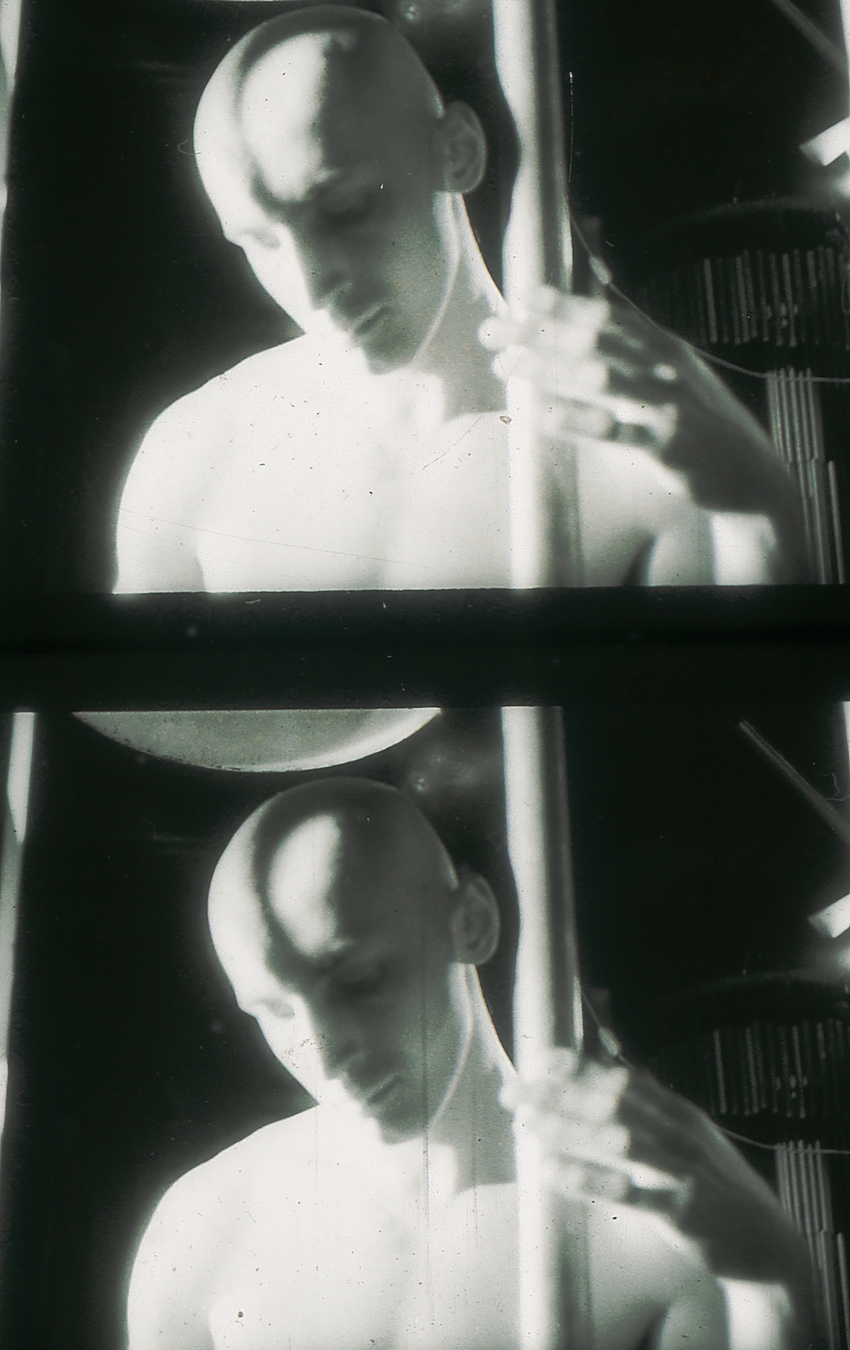
The screenplay was written as a self-deprecating story that traced the origins of the BICAPO mystery play, with which I have been involved since 1984. The plot calls for the cross-breeding of a man (the director of a metallurgical factory serves as a sperm donor) and an ape resulting in the creation of a biorobot with enhanced physical endurance for the manual transport of heavy things at a metallurgical factory. While transporting metal ingots, the hero-biorobot starts listening to the sounds of metal, escapes from the factory and starts creating his own music using new metal music instruments that he invents, and when he performs in mystery plays for the public, he interconnects all the primary elements – fire, water, air, earth and metal. The society rudely intrudes into the hero’s new life and brings him back to his former work at the factory. The hero breaks down under the workload and dies. He is thrown out to the scrap yard where he used to gather the material for creation of his instruments.
German Vinogradov
Artist, poet, musician, actor. Born in 1957 in Moscow, USSR. From 1976 to 1983, student at the Department of Architecture of Moscow Institute of Land Use Planning Engineers. From 1984, participant of numerous art groups. Founder of mystery art in contemporary Russia. Vinogradov regularly stages the mystery play “Bicapony of Heavenly Forest” using the BICAPO environment that consists of a huge number of the author’s sound sculptures. He is the first artist in contemporary Russia to introduce fire, water and other primary elements as an integral part of mystery plays held in enclosed spaces. He held over 2000 mysteries in Russia, Europe, USA and Canada. Influenced by the system of Porfiry Ivanov, Vinogradov created several unusual forms of creative work, in which cold, snow and cold-water dousing as well as dipping in icy water became a component part. Author of performances with the burning of land-art objects of Nikolay Polissky in the Nikola-Lenivets Park (Russia, 2006, 2012). Lives and works in Moscow, Russia.
Alexander Shishkin-Hokusai (Ru) - Bath of Marat
Supported by CYLAND MediaArtLab

Simulated wings are immersed in tubs filled with black paint and they flap, bringing to mind birds soiled by oil spills at sea. The work refers to the subject of Icarus: the aspiration towards beautiful ideas followed by a fall into the depths of crap. On the other hand, the wings function as the giant brushes of an artist. The customary artisanal world of a creator can also be interpreted as an endless immersion in light and darkness.
Alexander Shishkin-Hokusai
Artist. Born in 1969 in Leningrad, USSR. Graduated from the Leningrad Institute of Theatre, Music and Cinematography. He has worked as a theatre artist since 1995; collaborates with such directors as Yury Butusov, Andrey Moguchy, Adolf Shapiro. As a scenographer and costume designer, he worked in theatres in Russia, Norway, Poland, Bulgaria, South Korea, China. A repeated winner of the theatre award “Golden Mask” (Russia). Since 2010, a member of the artists’ union PARAZIT. Since 2014, a participant in the projects of CYLAND Media Art Lab. Lives and works in St. Petersburg, Russia.
Peter Patchen (USA) - Vigilance
24” x 24” x 29” (Variable)
Mixed Media: E-waste, 3D Print, Theremin
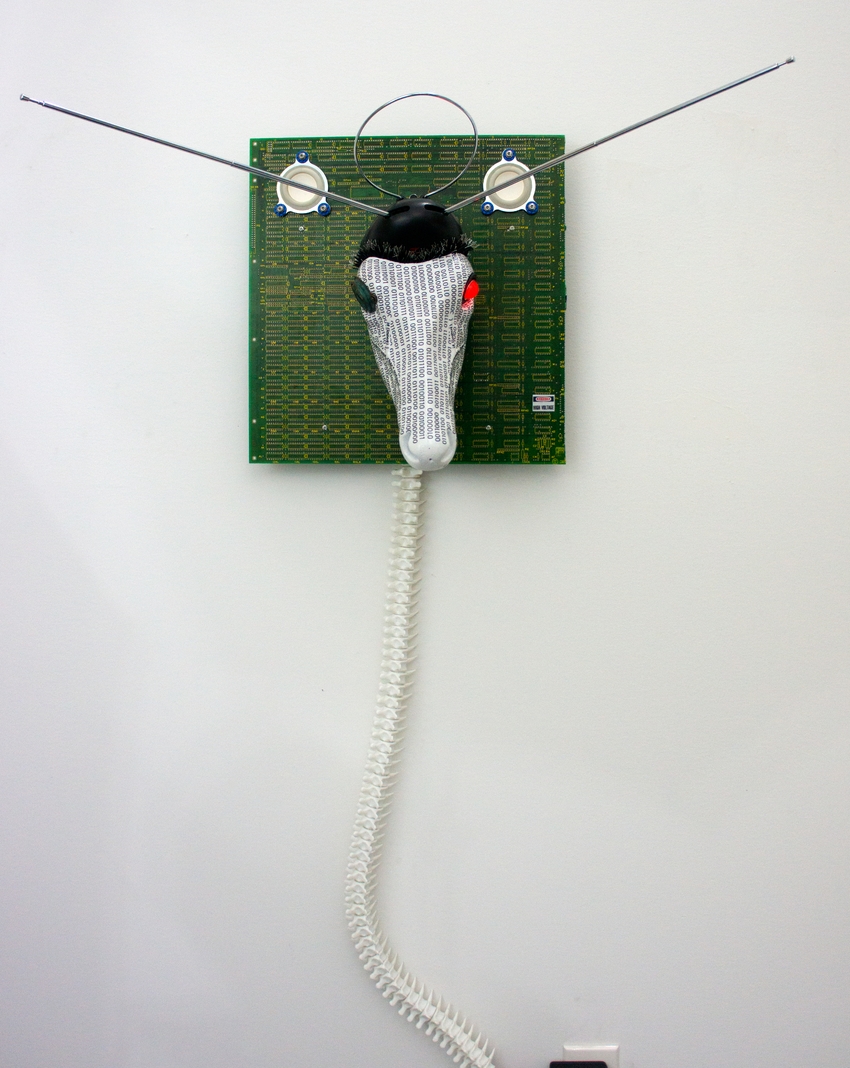
In work Vigilance, from the Campfire Tales series, Patchen mounts a deer head covered in code on a circuit board that incorporates 3-D printing and e-waste. The piece references the human trophy-taking impulse as it combines the natural and digital worlds ultimately calling into question our own behavior, consumption and its impact on the planet. Reflecting the wariness of an endangered animal, the antlers/television antenna is a functioning theremin that fills the space with static at varying pitches when the viewer is near. The binary code, a snippet of the Stux virus, textures the beast while its meter/eye measures the environment in vain.
Peter Patchen
Artist, art educator. Born in the USA. He grew up in Colorado where the natural environment had a profound influence on his perception of the relationships that exist between nature, humanity, culture and technology. Earned a MFA from the University of Oregon (Eugene, Oregon, USA). In 1993, he founded the New Media program at the University of Toledo (Toledo, Ohio, USA). Currently he is the Chair of the Department of Digital Arts at Pratt Institute (New York, USA). He maintains a studio in the Red Hook area of Brooklyn (New York, USA).
Ivan Govorkov, Elena Gubanova (Ru) - Death Grip of Life
Engineers: Aleksey Grachev, Sergey Komarov

The entire object is an enlarged copy of the household flytrap. The sticky sweet ribbon, in the artists’ ironic version, is a metaphor of life. People “stuck on” power, ideas and principles, sensual lust, love, time and space – the way flies get stuck at the honey-rosin bait.
Having come close, the viewer falls within the area of coverage of sensors. The entire construction comes into motion and starts vibrating and humming as if an insect had alit on it. The resonant and heart-rending sounds of a panicked desire of breaking loose leaves no hope for a happy end. In this grotesque form, the authors remind the viewer once again of the pernicious nature of human passions, dogmatic ideas and desires.
Ivan Govorkov
Artist. Born in 1949 in Leningrad, USSR. Graduated from the Ilya Repin State Academy Institute of Painting, Sculpture and Architecture (Leningrad, USSR). He is engaged in philosophy, psychology, painting, drawing, sculpture and installations; he works at the junction of traditional art and cutting-edge technologies. Professor of drawing at the Ilya Repin Institute. Recipient of the Sergey Kuryokhin Award (Russia, 2012) in the category “Best Work of Visual Art” (together with Elena Gubanova). His works have been exhibited at major Russian and foreign venues, including the Hermitage Museum (St. Petersburg, Russia), the Russian Museum (St. Petersburg, Russia), Museum of Moscow (Moscow, Russia), University Ca’ Foscari (Venice, Italy), Chelsea Art Museum (New York, USA), Kunstquartier Bethanien (Berlin, Germany), Sky Gallery 2 (Tokyo, Japan). Participant of the Manifesta 10 Biennale Parallel Program (St. Petersburg, Russia, 2014) and several exhibitions parallel to Venice Biennale (Italy, 2011, 2013, 2015); many times participant of the Cyfest Festival. Since 1990, he has been working in collaboration with Elena Gubanova. Lives and works in St. Petersburg, Russia.
Elena Gubanova
Artist, curator. Born in 1960 in Ulyanovsk, USSR. Graduated from the Ilya Repin State Academy Institute of Painting, Sculpture and Architecture (Leningrad, USSR). She is engaged in painting, sculpture, installations, and video. Gubanova’s principal interest as an artist is to explore the time-space notion in a social context and to present scientific discoveries through the figurative language of art. Recipient of the Sergey Kuryokhin Award (Russia, 2012) in the category “Best Work of Visual Art” (together with Ivan Govorkov). Her works have been exhibited at major Russian and foreign venues, including the Hermitage Museum (St. Petersburg, Russia), the Russian Museum (St. Petersburg, Russia), Museum of Moscow (Moscow, Russia), University Ca’ Foscari (Venice, Italy), Chelsea Art Museum (New York, USA), Kunstquartier Bethanien (Berlin, Germany). Participant of the Manifesta 10 Biennale Parallel Program (St. Petersburg, Russia, 2014) and several exhibitions parallel to Venice Biennale (Italy, 2011, 2013, 2015); many times participant of the Cyfest Festival. Since 1990, she has been working in collaboration with Ivan Govorkov. Lives and works in St. Petersburg, Russia.
Valentina Povarova (Ru) - Сross
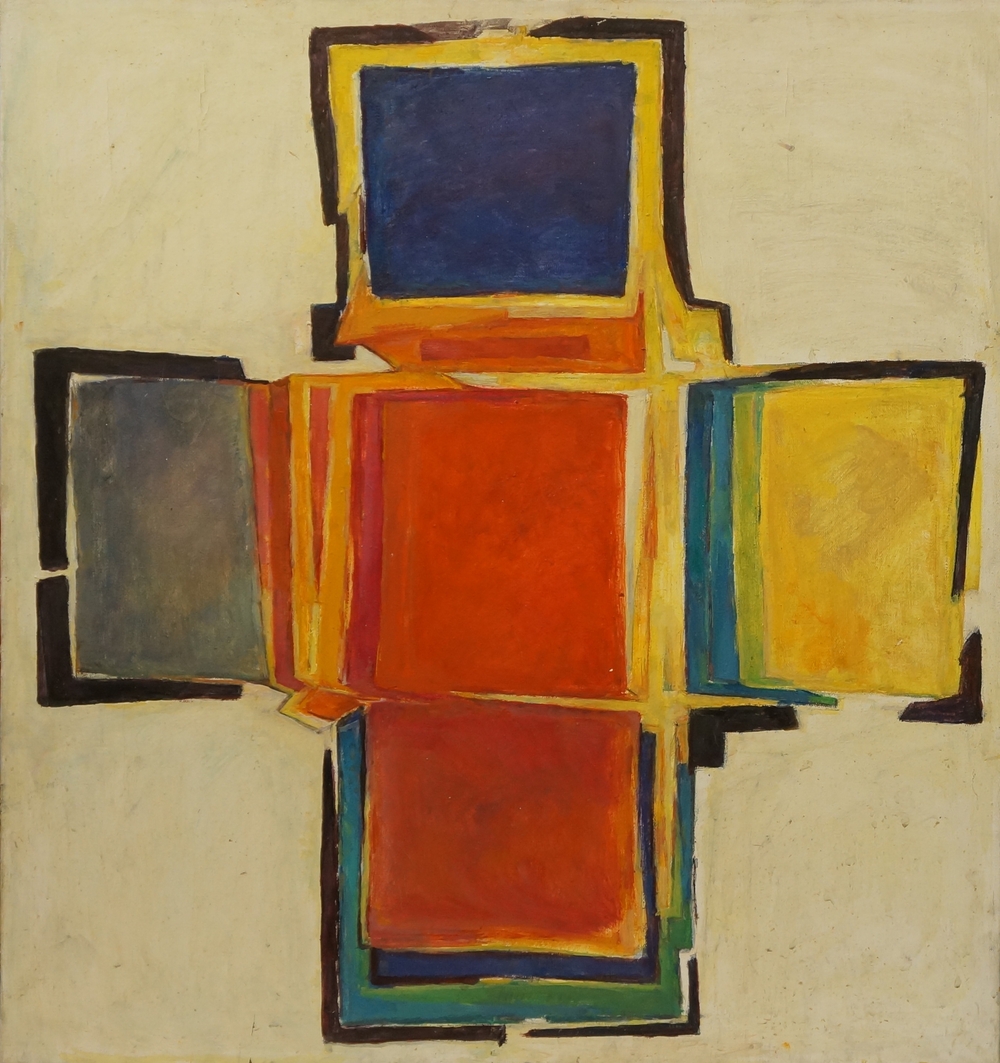
“…As an artist, I am attracted not to the empiric existence, psychology, morals, societal issues, but by the sense of transcendental that is behind all that. A power is also the hatred of everything profane in
oneself…
…I think that, through the works, one gets the feeling of belonging to the supreme invariable origins.
If this pans out – the artist is happy. This is probably the reason one is working to begin with.
Artworks as a whole are a metaphysical object. This provides instants of happiness and of overcoming of the anonymity in the world.
…The name of Malevich is charismatic for me – and the longer I live, the stronger it becomes. The flame
does not go away…
… Prime structure. It is born in the painting and cannot be explained by words. I am possessed by the color… It gets born, attracts the form… Some kind of vibration emerges from within, and it is, in fact, purely plastic, of the color-shape nature.
…Colors and shapes are the protagonists in my works. One could dedicate entire cycles of paintings to the joy one derives from a single color – from its capacities. The important thing, the thing that moves it all, is energy. The energy that fills life in all its shapes and manifestations…”
Valentina Povarova
Artist, art educator. Born in 1933 in Leningrad, USSR. Graduated from the Ilya Repin State Academy Institute of Painting, Sculpture and Architecture (Leningrad, USSR). Taught at the Department of Drawing at the Herzen Institute (Leningrad, USSR). In the late 1960s Povarova met Pavel Kondratyev (pupil of Malevich, Filonov and Matyushin) and the artist Vladimir Volkov. From that time on, there was a period of active creative meetings and collaboration on studies of the legacy of the Russian avant-garde. From 1970 to 1988 Povarova was a professor at the Department of Painting and Drawing of the Vera Mukhina Higher School of Art and Design (Leningrad, USSR). She developed and made part of the curriculum a unique course of “color science” that was based on the legacy of the school of Malevich (the GINKhUK) and the art systems of Filonov and Matyushin. She participated in the so-called “apartment exhibitions”. Her works are in the collections of the Russian Museum (St. Petersburg, Russia), Arkhangelsk Museum of Fine Arts (Russia), “Tsarskoye Selo Collection” (Pushkin, Russia) and others. Died in 2007.
Boris Kazakov (Ru) - Stakes

Eugene Yufit was finishing gluing together his film Silver Heads when we ran into each other in the editing room on the Kryukov Canal and he said that I could take away those clippings of the film positive that ended up on the editing-room floor. So I brought to Moscow a trunk-full of film footage. I did some reviewing, selecting, adding and additional drawing, which resulted in a short spin-off film.
Boris Kazakov
Artist, filmmaker. Born in 1964 in Leningrad, USSR. Graduated from the Institute of Machine Building LMZ-VTUZ (Leningrad, USSR). Kazakov started painting in the late 1980s. In 1996 he made his first film “Nestlings of the Sea” using the technique of drawing on film which is traditional for parallel cinema. He also experimented with different methods of animation without a camera and invented a way to shoot movies with a photo camera. Recipient of the Grand Prix of the Kinoshok Film Festival (Anapa, Russia, 1999). Lives and works in St. Petersburg, Russia.
Alvise Bittente (It) - Basilisk (Slimy-Grimy)

The work stands on the axis between the myth of basilisk, “king of serpents”, whose gaze turned everything to stone, and the play “Arden of Faversham” by an anonymous Elizabethan author, in which the protagonist Alice and her lover paid Clarke, a painter who was an expert in mixing venom into oil painting, to create a portrait that would be hung in her husband’s room and kill him at first glance. Art gives a different meaning and other points of view to a basilisk that petrifies with a gaze, and perhaps by looking and staring at art in excess we are risking poisoning it.
Alvise Bittente
Artist. Born in 1973 in Venice, Italy. Graduated from the Academy of Fine Arts in Venice, Italy, with a thesis that explored the role of design in contemporary art. Participated in numerous group and solo exhibitions. His science-fiction story “3.600 Spazi Inclusi” was published in 2012 and then became a reading performance in 2013. He created the installation “A Time out of Joint” that included a theatre performance “Impasto a Shakespeare”, in which he also starred. Lives and works in Venice, Italy.
Alexei Kostroma (DE), Ivan Govorkov (Ru), Elena Gubanova (Ru) - Garden of Malevich
Introspective action, 05.17 – 11.05.1992
Historic building of the Russian Academy of Arts – Russian Ethnographic Museum, St. Petersburg
Chief participants of the project: Aleksey Kostroma, Ivan Govorkov, Elena Gubanova
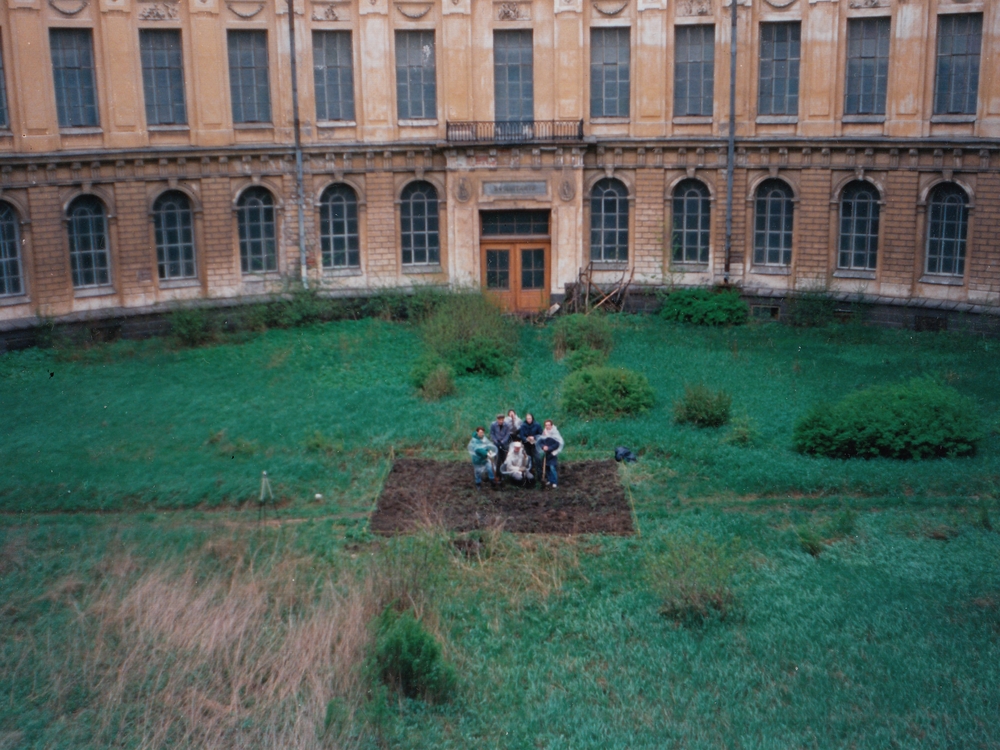
On May 17, 1992, the group of artists TUT-I-TAM (HERE-AND-THERE), former students and graduates of the Leningrad Academy of Arts Alexei Kostroma, Ivan Govorkov, Elena Gubanova and their friends, organized the action “GARDEN OF MALEVICH”. The chief idea was about sowing the seeds of new art in the very heart of an orthodox art institution under the conditions of new time of a nascent democracy in Russia.
Timeline of the events:
May of 1992
dug up a black square in the round courtyard of the Academy of Arts in Leningrad.
Sowed carrot seeds.
November of 1992
Unearthed the carrots.
Walked over the Palace Bridge with 3-meter sculptures of the carrot from the Hermitage to the Rostral Columns, having crossed the Neva as a symbolic Rubicon of time. This action was a remake of the futurist manifestation of Morgunov-Malevich on February 8, 2014, in Moscow.
The final action was the eating of the gathered carrots at the exhibition-installation at the Russian Ethnographic Museum as an act of destruction of the Black Square itself.
“To open ground in the round courtyard of the orthodox Academy of Arts with the Black Square of suprematism, to plant it with seeds and wait until the form, which germinates in a plane, is born and gets eaten in real life”.
Ivan Govorkov, 1992.
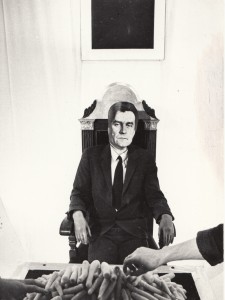
The introvert nature of Black Square, its inaccessibility for the uninitiated, which, it its turn, serves as a constant irritant and a disturber of peace and, after the consumption of its fruit, turns into a quite accessible and ordinary image. In reality, what’s happening is a qualitative and quantitative change of the square that illustratively demonstrates parallels of the creative and biological processes whose approximation we dare to declare here. In 1915, in Petrograd, in the first quarter of the XX century, the great Master published with his black square the final result of his multiyear digestion of Russian and Western Art. But does the final result in art exist? And isn’t the final result just a new beginning?
Alexei Kostroma, 1992.
Alexei Kostroma
artist, theorist, researcher
Born in 1962 in Kostroma, Russia. Graduated from the Academy of Fine Arts (Repin Institute), Department of Painting, in 1989 in Leningrad (Saint Petersburg). Works in media: painting, object, installation.
In the early 1990s proclaims a new trend in contemporary art – ORGANIC WAY, connected with the study of the laws of development of animate nature that allowed Kostroma to form his personal approach and his concept of the relationship between aesthetic theory and creative practice in contemporary art. His oeuvre is always rooted in research regarding the process of interaction between nature and man, and he strives to integrate the resulting knowledge into the social environment. The artist always follows several directions of the development of his subject, speaking about internal problems of human existence through the laws of the functioning of nature and perceiving the world as a single entity. “ORGANIC WAY is a way of knowledge the unity of meanings”.
Installation “UNO” was nominated by Kandinsky Prize as the Best Project of a Year 2011 in Moscow.
Public collections: Stedelijk Museum, Amsterdam; State Hermitage, State Russian Museum, Saint Petersburg;
State Tretyakov Gallery, Multimedia Art Museum, Moscow; Museum of Organic Culture, Kolomna
Lives and works in Berlin.
Ivan Govorkov
Artist. Born in 1949 in Leningrad, USSR. Graduated from the Ilya Repin State Academy Institute of Painting, Sculpture and Architecture (Leningrad, USSR). He is engaged in philosophy, psychology, painting, drawing, sculpture and installations; he works at the junction of traditional art and cutting-edge technologies. Professor of drawing at the Ilya Repin Institute. Recipient of the Sergey Kuryokhin Award (Russia, 2012) in the category “Best Work of Visual Art” (together with Elena Gubanova). His works have been exhibited at major Russian and foreign venues, including the Hermitage Museum (St. Petersburg, Russia), the Russian Museum (St. Petersburg, Russia), Museum of Moscow (Moscow, Russia), University Ca’ Foscari (Venice, Italy), Chelsea Art Museum (New York, USA), Kunstquartier Bethanien (Berlin, Germany), Sky Gallery 2 (Tokyo, Japan). Participant of the Manifesta 10 Biennale Parallel Program (St. Petersburg, Russia, 2014) and several exhibitions parallel to Venice Biennale (Italy, 2011, 2013, 2015); many times participant of the Cyfest Festival. Since 1990, he has been working in collaboration with Elena Gubanova. Lives and works in St. Petersburg, Russia.
Elena Gubanova
Artist, curator. Born in 1960 in Ulyanovsk, USSR. Graduated from the Ilya Repin State Academy Institute of Painting, Sculpture and Architecture (Leningrad, USSR). She is engaged in painting, sculpture, installations, and video. Gubanova’s principal interest as an artist is to explore the time-space notion in a social context and to present scientific discoveries through the figurative language of art. Recipient of the Sergey Kuryokhin Award (Russia, 2012) in the category “Best Work of Visual Art” (together with Ivan Govorkov). Her works have been exhibited at major Russian and foreign venues, including the Hermitage Museum (St. Petersburg, Russia), the Russian Museum (St. Petersburg, Russia), Museum of Moscow (Moscow, Russia), University Ca’ Foscari (Venice, Italy), Chelsea Art Museum (New York, USA), Kunstquartier Bethanien (Berlin, Germany). Participant of the Manifesta 10 Biennale Parallel Program (St. Petersburg, Russia, 2014) and several exhibitions parallel to Venice Biennale (Italy, 2011, 2013, 2015); many times participant of the Cyfest Festival. Since 1990, she has been working in collaboration with Ivan Govorkov. Lives and works in St. Petersburg, Russia.
CYLAND AUDIO ARCHIVE presentation (curator – Sergey Komarov):
ARTISTS: Nick Edwards, Peter Vogel, Hans Tammen, Dmitry ::vtol:: Morozov, Kurvenschreiber, Art Electronix, Pete Um, Jonáš Gruska, Yoshio Machida, Anthony Bisset, Vasily Stepanov, Sashas Ulz, George Bagdasarov, Max Kuiper, Thorsten Soltau, Mark Hannesson, Akira Rabelais, Todd Barton, Zimoun, Alexei Grachev, Bred Blondie, A. Nigh Herndon, Glia/Bugaev, Ilia Belorukov, Lena Filatova
See Also
- CYLAND Presents New Media Installation in St. Petersburg
On December 3 at the TAIGA Space in St. Petersburg CYLAND MediaArtLab presented new installation…
- DiMoDA, Digital Museum of Digital Art in Virtual Reality
As the preeminent Virtual institution devoted to Digital/New Media Art, the Digital Museum of Digital…
- CYLAND Artists Perform at m_division's Project Opening
March 25 m_division unveils a new project «Artification», aimed at supporting and presenting several facets of contemporary art,…
